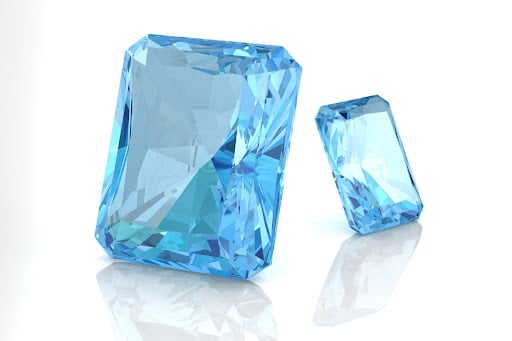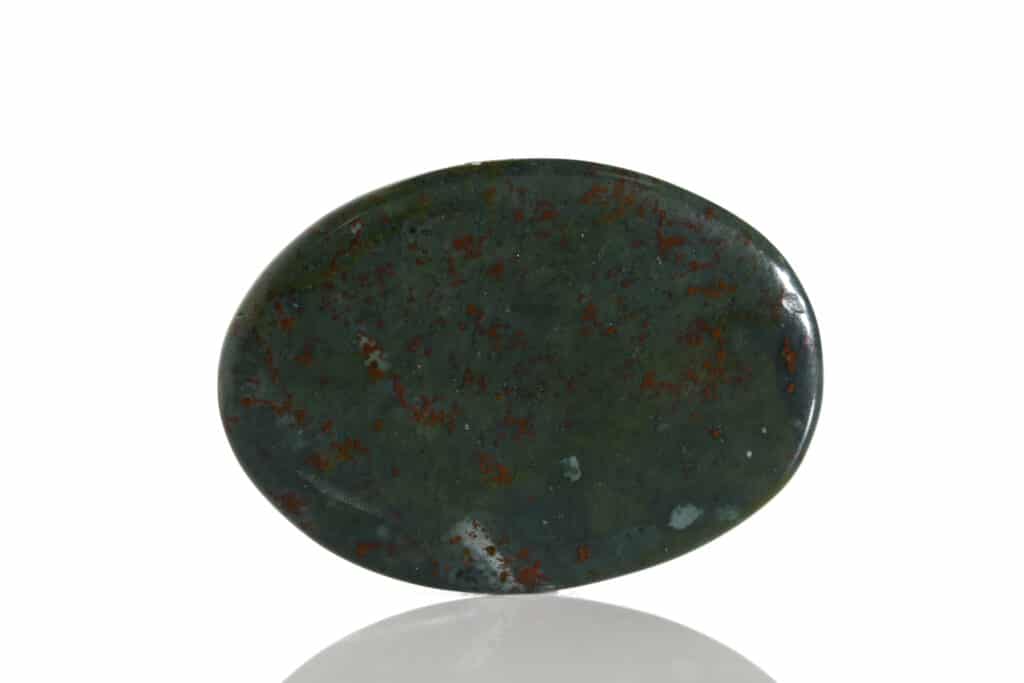If your birthday is in March, you may already know that your birthday month comes in like a lion and goes out like a lamb. But are you aware that your birth month has not one, but two, distinct yet equally beautiful birthstones?
If you’re one of the many people out there born in March, you can choose either the brilliant aquamarine or the mysterious bloodstone as the birthstone to call your own. Both have their own unique charm and attractive characteristics. Regardless of which one you select, both aquamarine and bloodstone will undoubtedly make you proud of your March birthdate.
Aquamarine: The Spirit of the Sea
Without knowing anything about aquamarine itself, anyone who looks at it will probably relate it to one image above all else — the beauty and majesty of the ocean. This gem has a serene and oceanic blue coloration. So it’s fitting that its name is derived from the Latin terms for “water” (aqua) and “the sea” (marina).
In fact, so evocative of the sea is the gem’s beautiful coloration, the ancient Romans actually believed that aquamarine would serve as a good luck charm for sailors during long sea voyages.
Later, western cultures came to see aquamarine as symbolizing healing, calm, happiness, and tranquility, especially between married couples — this may explain why it has become a popular choice for an engagement ring.

Aquamarine Comes in Several Color Choices
Similar to other popular gemstones — like emeralds — aquamarine is derived from a mineral called “beryl,” a silicate mineral made from the chemical elements beryllium and aluminum, and it’s responsible for aquamarine’s color.
Most aquamarine gems are a peaceful light blue, reminiscent of a tranquil ocean or lake. Nonetheless, their color can range from a darker blue to bluish-green.
In general, the darker the coloration of aquamarine stones, the more valuable they are. Also, larger aquamarine stones usually have a deeper, more intense coloration. Where Does Aquamarine Come From?
Today, aquamarine can be found worldwide. But most of the aquamarine gemstones are mined in Brazil, where the largest mineral deposits of “beryl” are located. Other countries that produce large supplies of aquamarine are Pakistan, Madagascar, Nigeria, Mozambique, Zambia, India, Russia, China, and the United States.
Natural aquamarine deposits tend to grow rather large — up to six feet in length. Because of the large deposits, gemstones can be cut into larger carats that stand out if used in jewelry or timepieces.
This characteristic combined with its eye-grabbing blue coloration makes it an ideal birthstone gem for those born in the month of March.
Bloodstone: Turning the Sun
The serene beauty of aquamarine certainly makes it a desirable choice of gemstone, but many people who have March birthdays may want something darker and more mysterious for their jewelry of choice. Fortunately, all of you March babies out there have another birthstone to choose from — the deep, powerful, nocturnal beauty: bloodstone.

Mysterious Coloration of Bloodstone
Contrary to the overt, serene blue of aquamarine, bloodstone has a very dark greenish-blue coloration, speckled with dots of a deep red color reminiscent of blood. These “blood” specks are actually made up of iron oxide. However, when contrasted with the near-black green of the surrounding stone, the red coloration evokes a haunting, mysterious effect upon the viewer.
Bloodstone is made up of cryptocrystalline quartz, a form of silicon dioxide with very minute crystalline properties. Consequently, bloodstone is sometimes called “blood jasper” as it often naturally occurs as a form of jasper, which is an “opaque” variety of silicon dioxide.
Bloodstone and the Sun
Bloodstone is regarded as a “heliotrope” — an ancient Greek term for “to turn the sun” — because of the ancient belief that bloodstone has magical properties upon the sun itself, affecting the motion of the sun if put into water. This belief likely came from the gem’s reflective effects when exposed to sunlight.
This belief shows you just how impressive bloodstone’s physical characteristics are upon the naked eye.
Where Does Bloodstone Come From?
Bloodstone is commonly found in countries like Brazil, Australia, India, the United States, Canada, and parts of Europe.
It’s often found as pebbles or embedded in rocks, usually within streams or river beds. Due to its natural shape, it can be crafted into a variety of cuts, including traditional ovular or cushion shapes, as well as more novel ones to suit a variety of different tastes and preferences in terms of jewelry.
Quality Standards for March Birthstones
Though aquamarine and bloodstone both have distinct qualities that appeal to different tastes, you need to look at a few key factors when looking into either of them. When shopping for the perfect March birthstone for yourself or a loved one, you should pay attention to these “four C’s”:
- Color: For aquamarine, a darker, deeper blue color tends to indicate a higher value. For bloodstone, look for a very dark green — almost black — color marked with deep but distinct red markings.
- Cut: Both the gemstones can be cut into various shapes, but the most common cuts are oval or cushion.
- Clarity: While aquamarine should generally be clearer, proper bloodstone is more opaque than other gems.
- Carat: Aquamarine of over 25 carats tends to be less valuable per carat than smaller aquamarine of similar quality. Bloodstone’s value tends to be determined more often by color than carat weight.
Choose Your March Birthstone Today
If you’re a March baby, you already have your choice of Winter or Spring, and now you know you have your choice of the beautiful aquamarine or the mysterious bloodstone as well.
Whether you prefer the serene, oceanic tranquility of aquamarine or the profound, magical alchemy of bloodstone, Brinker’s Jewelers has the best variety of jewelry, watches, and other accessories for either. So, if you or your loved one has a birthday in the month of March, browse through our March birthstone jewelry selection on our website to get started on your aquamarine or bloodstone shopping!
















